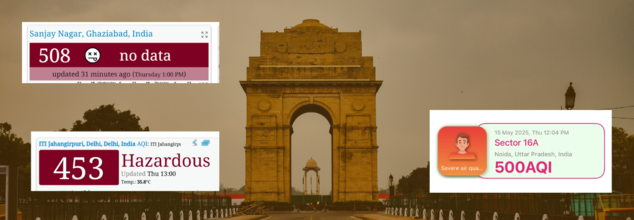- Health Conditions A-Z
- Health & Wellness
- Nutrition
- Fitness
- Health News
- Ayurveda
- Videos
- Medicine A-Z
- Parenting
- Web Stories
Eye Care Recall Hits 75,000 Products - Here's What You Can Use Instead

Credits: Canva
If you are someone who suffers from dry and itchy eyes, a recent update may not be the best news for you. As per the enforcement report from the Food and Drug Administration (FDA), 75,000 cases of eye drop solution were voluntarily recalled nationwide by the BRS Analytical Service, which is a pharmaceutical testing lab.
Why Are These Products Recalled?
The recall came in the backdrop of FDA audit at BRS Analytical Service, which found a number of Current Good Manufacturing Practice (cGMP) deviations. These are a set of regulations enforced by the FDA to ensure that manufacturers use safe practices to produce pharmaceutical products, reports NBC news.
"cGMP deviations may lead to products of unacceptable quality, and it is not possible to rule out patient risks resulting from use of these products,” said AvKare, which is a manufacturer of medical, surgical, and pharmaceutical items, which had originally reported the recall.
Furthermore, as per the enforcement record, the recall is also "due to a lack of assurance to sterility". These products are also described as "eye lubricants", which help relieve dry and irritated eyes.
Which Products Have Been Recalled?
NBC news reports that the recall includes ophthalmic solutions shipped over a two year period from: May 26, 2023 until April 21, 2025, according to AvKare.
- NDC# 50268-043-15 Artificial Tears Ophthalmic Solution
- NDC# 50268-066-15 Carboxymethylcellulose Sodium Ophthalmic Gel 1%
- NDC# 50268-068-15 Carboxymethylcellulose Sodium Ophthalmic Solution
- NDC# 50268-126-15 Lubricant Eye Drops Solution
- NDC# 50268-678-15 Polyvinyl Alcohol Ophthalmic Solution
So, What Can You Do Instead?
Dr Anita Sethi, who is Principal Director and HOD Ophthalmology, Max Multi Specialty Centre at Panchsheel Park recommends to stay away from natural remedies like haldi (turmeric) or ginger from putting inside the eye.
In absence of eye lubricants, she recommends certain daily habits that can help protect the eyes from dryness. "In the extremely dry and hot weather, we need to protect our eyes by wearing sunglasses or caps and avoid the direct dust and wind going into the eyes when we are sitting in an air-conditioned room or the fan avoid the blast directly in your face, like when you're driving. Keep the vents so that it is away from your face and not going directly into the eyes."
When asked if there are anything one can eat to ensure their eyes are not dry, she said, "food and nutrients that help with dry eye basically just maintaining the health of the eye, which is foods rich in vitamin E, antioxidants. Coloured vegetables and fruits and even maintaining your thyroid and vitamin D levels because these also contributes to dry eye."
The key to ensure that your eyes are protected from environmental factors like sun, dust, and eat, especially for those who work outdoors or spend long hours on screen, she recommends investing in good sunglasses with ultraviolet protection.
"For those who are using computers a lot, you need to blink your eyes constantly, take breaks in between, and drink a lot of water. Dehydration is also contributing factor to dry eye." She also recommends using a zero number protective glasses and computer glasses that can decrease strain and dry eye.
Scented Candles Are Harming Your Lungs—Here's How

Credit: Canva
Scented candles have taken the market by storm. Known to be therapeutic, these candles are quickly making their way into our houses. However, researchers have raised the flag over the toxicity of one of its components—Terpenes. A new study has shown that particles eliminated from burning scented wax melts indoors can create a "tremendous amount" of indoor air pollution, similar to that created by pollution caused by diesel engines. Intrestingly, Terpenes are the components that give wax candles its scent.
Since these particles actively alter indoor air chemistry, they could have significant health implications. The processes should be considered in the design and operation of buildings and their HVAC systems to reduce the exposure. Zepbound helped nearly 25% more participants lose more than 15% of their weight compared to Wegovy, Lilly said on Sunday.
Trial also showed that treatment with Terpenes are naturally occurring volatile organic compounds (VOCs) found in many plants and are commonly used in household products like air fresheners, scented candles, cleaning agents, and essential oils. While they contribute pleasant aromas, terpenes can significantly impact indoor air quality through chemical reactions that produce harmful pollutants.
How Terpenes Contribute To Indoor Air Pollution
When terpenes are released indoors, they can react with oxidants such as ozone (O₃) and hydroxyl radicals (OH), leading to the formation of secondary pollutants:([PubMed][1])
Secondary Organic Aerosols (SOAs): These are fine particulate matters formed from the oxidation of terpenes. SOAs can penetrate deep into the respiratory system, potentially causing health issues.([PubMed][1])
Formaldehyde: A known irritant and potential carcinogen, formaldehyde can form as a byproduct of terpene reactions.([PubMed][2])
Ultrafine Particles: Particles smaller than 100 nanometers can result from these reactions, posing risks due to their ability to enter the bloodstream.
These reactions are particularly concerning in enclosed spaces with limited ventilation, where pollutant concentrations can accumulate to levels that may affect human health.
Notable Study: Purdue University Research on Scented Wax Melts
A study conducted by Purdue University investigated the impact of scented wax melts on indoor air quality. The researchers found that burning these products releases terpenes, which react with indoor ozone to form nanoparticles. The concentration of these particles was comparable to those emitted by diesel engines, highlighting a significant source of indoor pollution. The study emphasized the need for further research into the health implications of these particles and suggested that building designs and ventilation systems should account for such chemical processes to minimize exposure.
With Flu On The Rise And COVID Still Lurking, Can You Get Your New Vaccinations Together?

As flu cases spike and COVID-19 continues to be a lingering threat, a lot of people are faced with a familiar question: can you receive your influenza and COVID-19 vaccines simultaneously? With both viruses this year, timing and how you get vaccinated are more important than ever. Planning out vaccine schedules is complicated, but new scientific findings and public health recommendations provide clarity and convenience. Here's an in-depth rundown of everything you should know to remain safe this season.
Both respiratory viruses can lead to serious illness and even death, particularly among high-risk groups. Although the COVID-19 pandemic has been making headlines for years, flu is a significant public health threat, with yearly outbreaks rushing millions to hospitals around the globe.
Vaccines are still the best protection against these diseases. They do more than just lower the risk of infection; they also lower the severity if you do become infected. And yet, even when widely available, many have trouble keeping up with recommended vaccinations- a process referred to as "vaccine fatigue." For many, having multiple vaccination visits squeezed into already full schedules contributes to the problem.
The good news is that you can now get your flu and COVID-19 vaccines in one visit. The Australian Department of Health supports this method as safe and effective. This two-in-one vaccination method not only saves time but also motivates more individuals to have both vaccines without delay.
Healthcare professionals, such as GPs and pharmacists, are now providing simultaneous vaccinations, appreciating the advantage of convenience without sacrificing safety. This will enable patients to reduce the inconvenience of multiple appointments and gain early protection against both viruses.
Should You Get the Shot Same Arm or Different Arms?
One question many have when receiving two vaccinations simultaneously is where the two shots should be given, same arm or separate arms. Although this has traditionally been a matter of individual choice or healthcare provider discretion, new studies indicate that there could be immunological benefits.
Animal model studies suggest that co-injecting the COVID-19 mRNA vaccine and the flu vaccine in the same arm may enhance immunity. The adjuvant effect built into the COVID vaccine—a lipid molecule that activates immunity—may have the ability to enhance the flu vaccine's impact if the vaccines are injected close together. But this is still an experimental area, and current clinical guidelines accept either option depending on comfort and convenience.
Early in the COVID vaccine rollout, health authorities advised spacing COVID-19 vaccines from other vaccines by a minimum of 14 days. This was out of caution because there was limited data then. Presently, with strong evidence in place, the Centers for Disease Control and Prevention (CDC) and global health agencies have revised their recommendations. COVID-19 vaccines may be given at the same time as other vaccines, such as the flu shot, without added risk.
This update eliminates barriers to logistics and allows individuals to remain up to date on all their vaccinations in one health care visit.
Experts stress not delaying either shot to time perfectly. The flu vaccine should ideally be given in early fall—September or October—so the immunity is up during the time of maximum influenza activity. If your COVID booster eligibility doesn't fall exactly together, it's best to take your flu shot on schedule and have the COVID booster as soon as it is available.
Those who are at greater risk, including immunocompromised persons and adults aged 65 and older, tend to be eligible for COVID boosters earlier and can take advantage of concurrent vaccination more easily. For the general population, flu shots should not be postponed until COVID booster availability, since both vaccines offer critical, time-sensitive protection.
Why Getting Both Shots Is Important?
The combined risk of COVID-19 and flu poses real threats to public health. Last season's flu was unusually light, arguably a result of universal COVID precautions such as masking and social distancing. As these behaviors loosen and social engagement picks up, the potential for a harsher season of the flu grows.
COVID-19 remains to circulate worldwide, new variants like the JN.1 subvariant triggering revised booster recommendations. Vaccination continues to be a bulwark to decreasing hospitalization, severe disease, and mortality from both viruses.
In the United States alone, COVID-19 has resulted in more than 650,000 fatalities, compared to the million-plus medical appointments and thousands of deaths caused by the flu during the 2019-2020 season. These numbers clearly highlight the critically important role dual vaccination plays, particularly as we navigate the ongoing changing dynamics of viral respiratory infections.
With the onset of flu season and ongoing COVID-19 cases, it is more critical than ever to remain current on vaccinations. The ease of getting flu and COVID vaccines at the same time eliminates a major barrier to safeguarding individual and public health.
If you have yet to get your flu vaccine, get it as soon as possible, don't hold off on your COVID booster if it hasn't been scheduled. Similarly, if you're due for a COVID vaccine or booster, don't delay getting one. You're helping keep yourself and the rest of the community safe, particularly those at highest risk of complications.
Delhi-NCR AQI Crosses 500, What Must You Do To Stay Safe

Credits: Canva
On May 15, Delhi-NCR woke up with a thick layer of smoke, many have felt the change instantly with their eyes getting dry, and facing difficulties while breathing. Photos too have come up from different parts of the capital, including the national capital region, including Noida and Gurugram that showed a thick layer of dust in the surrounding. The AQI has crossed 500 in certain places.
Air quality in Delhi deteriorated sharply overnight, with the AQI hitting 249 by 10 AM—classified as “poor”—as per SAFAR data. In several parts of Delhi-NCR, real-time AQI readings exceeded 500, falling into the “hazardous” category. According to the India Meteorological Department (IMD), strong dust-laden winds that began around 10 PM on Wednesday stirred up significant particulate matter, particularly PM10, triggering the sudden surge in pollution.
IMD scientist Krishna Mishra noted that by 9AM, the visibility had slightly improved to 1,500 metres with westerly winds at 10 km/hr, and said that further gradual improvement is expected as the day progresses.
Despite signs of improvement, the air quality remains hazardous—posing serious risks to children, the elderly, and people with existing respiratory issues. Even healthy individuals may experience short-term symptoms such as eye irritation, sore throat, and difficulty breathing.
Air Pollution Problem In India
Last month Health and Me reported the air pollution crisis India is facing, as it had surpassed the safety levels set by the World Health Organization (WHO).
This has posed a grave public health threat across the country. Not is it a concern for the capital city of Delhi, but for rest of the country too. The Director of WHO's Department of Environment, Climate Change and Health. Dr Maria Neira, recently also emphasized that while New Delhi gets the most media attention, especially during the winters, the problem extends far beyond its borders.
"There is a study which shows that we always focus on New Delhi when it comes to pollution, but I am afraid it is almost all of India where WHO standards on AQI are not implemented," pointed out Dr Neira.
India's air pollution is not just a seasonal or a regional problem. It is a year-round crisis that impacts vast sections of the population. As per the WHO guidelines, brief exposure to high levels of air pollutants can cause serious health problems. However, in India, several regions frequently record Air Quality Index (AQI) levels that are beyond safe limits.
Another report by University of Chicago revealed that air pollution is reducing the life expectancy of Delhi residents by 7.8 years. As per a US-based NGO report by the Health Effects Institute, there has been 30 to 50% increase in lung cancer rates associated with pollutants. A recent 2024 study also revealed that air pollution is not just linked to lung cancer but it can also cause head and neck cancer.
"Head and neck cancer is a harder link to show, and it has a much lower occurrence than lung cancers, but since they also occur as a result of smoking, similar to lung cancers, we wanted to explore any connections," said John Cramer, the study's lead researcher. "Presumably, the link to head and neck cancer comes from what we breathe to that material affecting the lining in the head and neck. We see a lot of occurrences of where carcinogens touch or pool in the body to where cancers can occur," he explained.
Tata Memorial Hospital published a study in July that revealed most people who had lung cancer in India never smoked.
On average, if you smoke a cigarette, you consume 1-2 milligram of nicotine. With nicotine, you are smoking somewhere between 7,000 to 8,000 different chemicals, which can cause cancer. These chemicals include carbon monoxide, nickel, PAHs, ammonia, nitrogen oxides, carbon dioxide, and many more such chemicals that also constitute air pollution.
So, What Can You Do To Safeguard Yourself Against The Air Pollution Crisis?
Gurugram-based pulmonologist and a member of DocTube, Dr Vivek Nangia suggests it is best to avoid going outside. However, if you must go out, it is best to go during the noon, as pollution levels are at the lowest during that time. There are certain things you can do after you reach home to cleanse yourself from pollution.
Make sure the air purifier is turned on once you are at home. Wash your hands, and your face, and take a glass of warm water, mix some salt in it and gargle with it. This will cleanse your trachea, that helps you transport air in and out of your lungs.
Experts also suggest consuming warm fluids, like green tea, herbal teas or soup. He also recommends to eat food rich in vitamin C as it has antioxidants and can help in reducing inflammation and protect mucous membranes in the throat and sinuses.
© 2024 Bennett, Coleman & Company Limited

